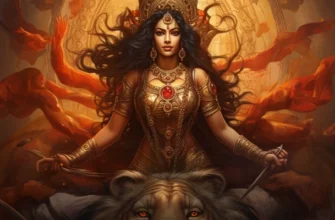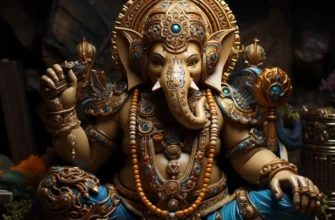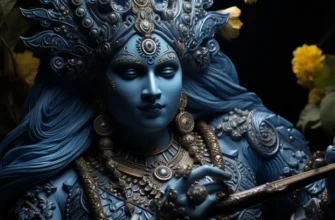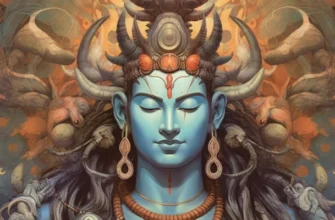Saraswati is one of the most revered Indian goddesses. She is known as the goddess of wisdom, art, music, and learning. Her symbols include a book, a lotus, musical instruments, and a spider.
In mythology, Saraswati is considered the daughter of the god Brahma, the creator of the world. Her cult is widely honored in India, especially during festivals dedicated to the goddess.
Saraswati influences the culture and art of India, providing inspiration to artists, poets, and musicians. She also has a great influence on global culture and leaves her mark on the modern world.
This goddess embodies the deep meanings of art, music and knowledge in Indian culture and is a symbol of spiritual development and harmony.
- Origin and legends
- Legends and myths associated with the goddess
- Symbolism and meaning
- Saraswati’s role in Indian mythology
- Religious rituals and festivals
- Worship practices and rituals associated with the goddess
- Influence on culture and art
- Saraswati’s influence on Indian art, literature and music
- Iconography and representation of the goddess in art
- Popularity outside of India
- Saraswati’s influence on global culture
- The spread of the goddess cult in the world, outside India
- Conclusion
Origin and legends
According to legend, Saraswati emerged from the divine water in ancient Indian myth. Her appearance is connected to the mythological stories of Hinduism, where she appeared as the daughter of the god of creation Brahma. She is considered the embodiment of knowledge, wisdom, art, music, and virtue.
According to the holy texts, Saraswati was given to Brahma from a lotus that appeared from his navel. Her name comes from the Sanskrit word saras, which means “flow” or “movement”. Her importance in mythology is reflected in her role as a patroness of knowledge and wisdom.
Legends and myths associated with the goddess
Saraswati has numerous legends that tell of her greatness and influence on the world. One of them tells about her singing competition with the god Ganesha, during which she lost her hat, symbolizing the loss of self-control. Another legend relates her appearance as an incarnation of the Saraswati River, which brought grace and fertility to yogis. In other stories, she is often depicted as a protector against evil spirits trying to prevent people from attaining knowledge and wisdom.
Saraswati, the Indian goddess of wisdom and art, has numerous legends and myths that tell of her greatness and influence:
The legend of a singing competition with the god Ganesha where she lost her hat, symbolizing a loss of self-control.
According to the legend, the goddess Saraswati and the god Ganesha participated in a singing competition during which they decided to test their musical abilities. Saraswati played his vinu, while Ganesha chose the drums. During the performance, Saraswati lost her hat, which was her symbol of self-control. She continued to play without undue anxiety, demonstrating grace and grace. This legend emphasizes the importance of self-control and elegance even in the most difficult situations.
The story of its origin as an embodiment of the Saraswati River, which brings grace and fertility to yogis and sages.
According to one legend, Saraswati was originally a river that flowed in Vedic India. This river played an important role in maintaining the fertility of the land and giving life to people and animals. Its waters were considered holy and amazingly gracious. In the course of time, its river image was personified into the divine form of Saraswati, who became the goddess of wisdom, art and learning. This legend emphasizes the goddess’s connection to the source of knowledge and success for people.
Saraswati is depicted as a protector against evil spirits who try to prevent people from attaining knowledge and wisdom.
In some versions of the legend, Saraswati is depicted as a protector against an evil spirit who tried to prevent people from attaining knowledge and wisdom. In these stories, the goddess fights this evil by using her grace, wisdom, and power over art and learning to protect her followers from darkness and the unknown. This legend emphasizes the importance of knowledge and wisdom in human life.
These legends have a profound effect on the perception of the goddess and her role in Indian mythology and culture.
Symbolism and meaning
Saraswati has deep symbolism and meaning in Indian culture:
Book: Symbolizes knowledge, wisdom, and learning.
Lotus: Indicates spiritual development and purity.
Musical instruments: Represent art and creativity.
Spider: Symbolizes fine work on art and literature.
Water symbols: Represent the wealth of knowledge and beauty that flowed from the rivers.
These symbols help to visualize Saraswati’s significance as the divine embodiment of knowledge, wisdom, art, and learning.
Saraswati’s role in Indian mythology
In Indian mythology, Saraswati plays an important role as the goddess of wisdom, art, music, and learning. She is considered the patroness of literature, art, music and all forms of learning. Her presence represents an important aspect of spiritual development and mental growth. In Indian mythology, she is the embodiment of the high ideals of knowledge, beauty, elegance and mercy. Her image reflects the importance of cultural and spiritual development in Indian society.
Religious rituals and festivals
Religious rituals and festivals dedicated to Goddess Saraswati include various rites of worship and celebration of her greatness:
Vasant Panchami: A festival celebrated at the beginning of the spring season when worshippers will bring her books and tools to receive her blessings.
Saraswati Puja: A religious ritual during which many teachers, students, and artists pray to the goddess for her blessings in learning and creativity.
Maha Saraswati Jayanti: The festival celebrating her birth is marked by prayers, songs and religious rituals in her honor.
These rituals and festivals reflect the great importance that the cult of Goddess Saraswati has in Indian society, especially in the context of learning and the arts.
Worship practices and rituals associated with the goddess
Worship practices and rituals associated with Goddess Saraswati include:
The beginning of schooling: In many Indian families, children begin their first schooling with Saraswati’s blessings to receive her support and wisdom.
Mantras and songs: Devotees use special prayers and mantras to address the goddess and ask for her blessings in their studies and creativity.
Rites at Shrines: Many Saraswati temples host religious ceremonies during which worshipers bring books, flowers, and other symbols of devotion.
These worship practices help to celebrate Saraswati’s importance as the patroness of knowledge and wisdom in Indian culture.
Influence on culture and art
Saraswati has influenced Indian culture and art in a variety of ways:
Literature and poetry: The goddess inspires poets and writers to create exquisite works that reflect her grace and beauty.
Music and art: Her presence in culture encourages musicians, painters and dancers to reveal their talent and creativity, and to pay homage to the arts.
Learning and education: Saraswati encourages the reverence for knowledge and learning, which stimulates the development of education and scientific achievements in the country.
Her influence on Indian culture and art emphasizes the importance of wisdom, beauty, and creativity in Indian society.
Saraswati’s influence on Indian art, literature and music
The goddess Saraswati has a significant influence on Indian art, literature, and music:
Literature: Saraswati is the patroness of words, literature and poetry. Her blessings are considered important to writers and poets, and they often ask her for inspiration and success in their work. Her presence in literary works is celebrated in literature in Sanskrit and other languages.
Music and art: The goddess Saraswati influences music and art in India, encouraging musicians, painters, and dancers to create works of art that express her beauty and elegance. She is often depicted with musical instruments, which inspires musicians.
Education: Goddess Saraswati is also important in education. Her cult encourages better learning and the development of knowledge.
Saraswati’s influence on these areas is invaluable, and she leaves her mark on India’s art, literature, and music, contributing to their development and flourishing.
Iconography and representation of the goddess in art
In the art of Indian culture, Saraswati is usually depicted with some characteristic attributes that reflect her greatness and symbolism:
A book: She may be holding sacred texts or an open book, indicating her patronage over knowledge and wisdom.
Musical instruments: She is often depicted with musical instruments, such as the vinu (stringed instrument), vinja (flute), or mridanga (drum), symbolizing her power over art and music.
Lotus: Her association with the lotus emphasizes her spiritual purity and beauty.
Spider: Sometimes a spider may be present next to her, reflecting her sophistication in art and literature.
These images help to represent Saraswati as the patroness of knowledge, art, and learning in Indian art and sculpture.
Popularity outside of India
The popularity of Goddess Saraswati extends far beyond India to many countries and cultural communities around the world. Her symbolism, which embodies knowledge, art and wisdom, resonates in many cultures as universal values.
In the modern world, its influence can be seen in various fields, including education, art, music and literature. Many people from different countries and cultures honor her as a symbol of wisdom, learning, and creativity, which is reflected in a wide range of global practices and the use of her images in art and religious practices.
Saraswati’s influence on global culture
The Saraswati cult has a great influence on global culture, especially in the areas of art, education, and creativity:
Art and Literature: Her influence has fostered literary and artistic works from around the world, reflecting the importance of knowledge and wisdom in the modern world.
Education and learning: Its symbolism encourages the development of education and scientific research, emphasizing the importance of knowledge in modern society.
Music and dance: It stimulates creativity in the fields of music and dance, inspiring artists from around the world to create works that express beauty and elegance.
This global influence of Saraswati’s cult helps to emphasize the importance of wisdom, beauty, and learning as universal values for the entire world.
The spread of the goddess cult in the world, outside India
The cult of Saraswati is widespread in many countries and cultures outside of India, particularly in Southeast Asia, where there are significant Hindu and Buddhist communities. In addition, the Indian diaspora living in different parts of the world also preserves and promotes the cult of Saraswati. Her importance as the goddess of wisdom, art, and learning is recognized in many cultural communities that value the values of knowledge and creativity. Thus, her cult penetrates different parts of the world and retains its importance in the context of the global cultural heritage.
Conclusion
Saraswati, the goddess of wisdom and art in Indian culture, is a symbol of greatness and beauty. Her influence on art, literature, music, and learning is reflected through age-old worship practices, rituals, and festivals that celebrate her important role in promoting knowledge and creativity. Her image and symbolism remain unchanged in both age-old traditions and in the global cultural context, emphasizing the importance of wisdom and beauty in all aspects of life. Saraswati remains a central figure in Indian culture and a prominent symbol of universal values that transcend national and cultural boundaries.








